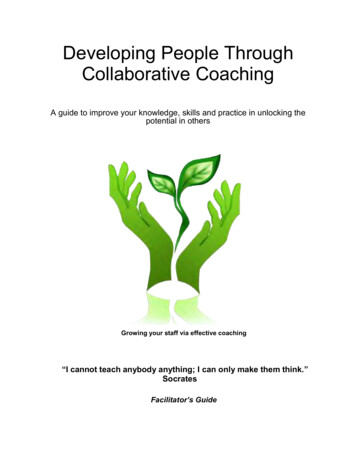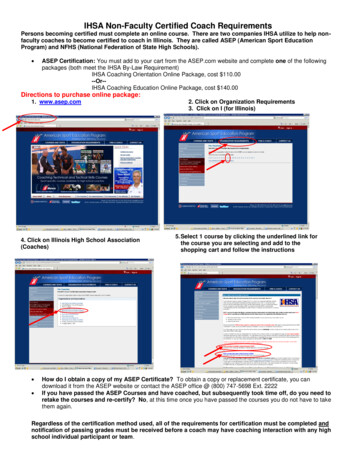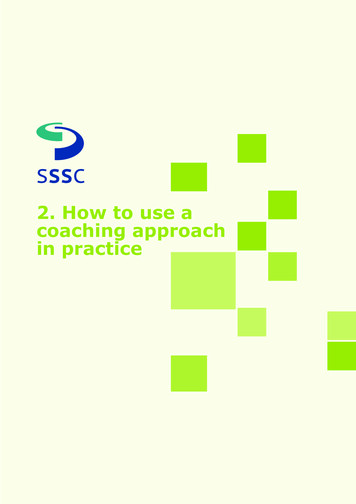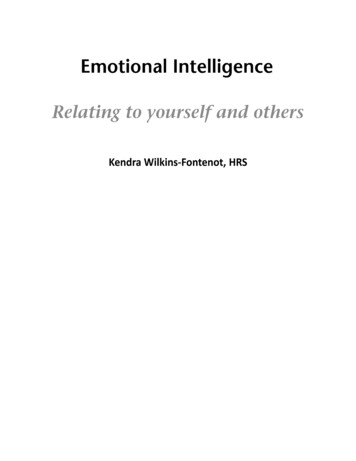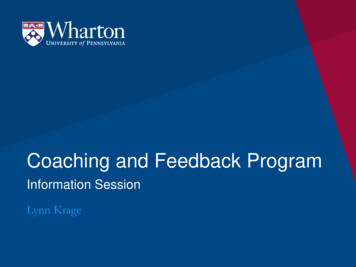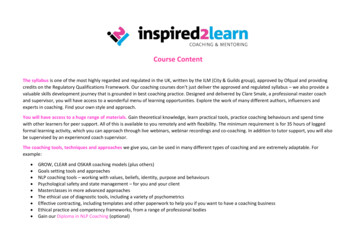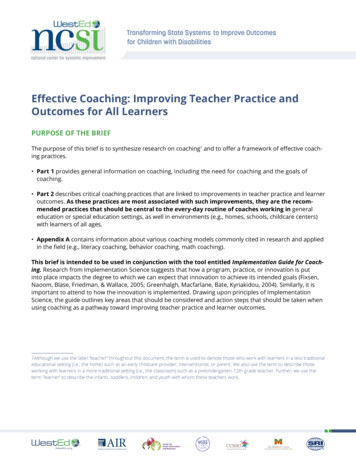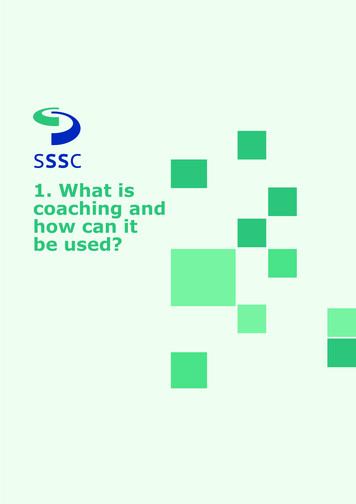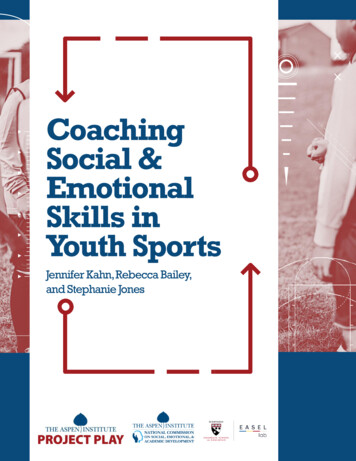
Transcription
CoachingSocial &EmotionalSkills inYouth SportsJennifer Kahn, Rebecca Bailey,and Stephanie Jones
TABLE OF CONTENTSI. IntroductionII. What are Social and Emotional Skills?III. Sports as an ideal place to build social and emotional skillsIV. Evidence from existing sports programsV. Key factors that support social and emotional skillsa. Importance of relationshipsb. Developmental considerationsc. Effective implementationd. Training and supportVI. Guidelines for coaches and other adultsa. Build positive adult-youth relationshipsb. Create a safe space that supports social and emotional skilldevelopmentc. Embody effective leadership strategies that emphasize effort,autonomy, and learningd. Prioritize and provide opportunities for direct skill building and practicee. Model good character and decision-makingf. Seek opportunities for support, training, and professional developmentg. Engage with families, schools, and other community organizationsThis white paper was commissioned by Susan Crown Exchange (SCE) to explore the role sportscan play in developing young people’s social and emotional skills.2
INTRODUCTIONResearch demonstrates a wide range of positive outcomes for children who are physicallyactive, including higher academic achievement, higher likelihood to attend college,increased success in the workplace, lower heath care costs, and decreased risk forobesity and other health problems (Aspen Institute Sport for All Play for Life; Menestrel &Perkins, 2007; Barber et al., 2001; Eccles et al., 2003; Eccles & Barber, 1999).Participation in sports has also been associated with a variety of social and emotionalcompetencies and related skills that we know from extensive research are essential tosuccess and well-being in school, work, and relationships. For example, children withstrong social and emotional skills are more likely to have positive work and familyrelationships, enter and graduate college, succeed in their careers, and have better mentaland physical health outcomes (Greenberg et al., 2017; Jones & Kahn, 2017; Jones &Kahn, 2018; Moffit et al., 2011; Weissberg et al., 2015). Focusing on social and emotionaldevelopment also has important implications for long-term social and economic outcomes.Evidence indicates that stronger social and emotional competencies are associated withhigher labor market earnings and productivity as well as reduced criminal behavior andsubstance dependence (Jones & Kahn, 2017; Moffit et al., 2011; Greenberg et al., 2017;Weissberg et al., 2015; Brunello & Schlotter, 2011). While all children, regardless ofbackground benefit from explicit instruction of these competencies, benefits may beparticularly strong for low-income or at-risk students. (Jones & Kahn, 2017; Jones, Brown& Aber, 2011; Aber et al., 2003; Capella et al., 2016). Social and emotional outcomes areparticularly sensitive to the negative effects of stress and trauma, making this workespecially relevant for children who are exposed to chronic stress often associated withpoverty, violence, and substance abuse (Center on the Developing Child, 2007; Evans &Kim, 2013; Noble, Norman, & Farah, 2005; Thompson, 2014). As such, focusing on socialand emotional skill development provides an important avenue through which to contributeto a more equitable society in which all children can thrive and succeed (Jones & Kahn,2017). Taken together, it is clear that supporting social and emotional skill development isessential not only to the success of individuals, but to society as a whole.In this paper, we define what it means to build social, emotional, and cognitive skills,particularly in the context of youth sports, and how coaches can integrate these practicesin their work with youth. It is important to note that psychosocial health (e.g., social andemotional well-being, positive youth development, etc.) and physical health areinterconnected (see box on next page), however, this paper focuses primarily on thedevelopment of social, emotional, and cognitive competencies and how these skills andcompetencies can be acquired and applied in sports settings.3
SOCIAL & EMOTIONALSKILLS AND PHYSICALACTIVITYA growing body of research suggests anunderlying reciprocal relationship betweenphysical activity and social and emotionaldevelopment. Physical activity requires coresocial,emotional,andcognitivecompetencies, and in turn, physical activityserves as an important context in which tobuild and promote social and emotional skills.For example, physical activity requires theuse of executive functions such as workingmemory, attention control inhibition, andplanning (McClelland & Cameron, 2018;Daly, McMinn, & Allan, 2015). Researchdemonstrates that these important executivefunction skills are associated with long-termmaintenance of physical activity participation(Mullen & Hall, 2015). Moreover, there isevidence that higher physical fitness isassociated with improved performance andproblem solving (Mullen & Hall, 2015;Lubans et al., 2016). Physical activity alsoprovides youth with opportunities to buildself-efficacy and perceived competence,which in turn, are associated with initiatingand sustaining physical activity (Kipp &Weiss, 2013).Participation in physicalactivity provides opportunities for participantsto learn and use important social, emotional,and cognitive skills that ultimately improveperformance and well-being in sports, school,and life.While it is clear that physical activity andsocial and emotional skill development aredeeply connected, there is still much to belearned about the underlying mechanismsthat link the two.4
WHAT ARE SOCIAL& EMOTIONALSKILLS?In recent decades, increasing attention has focused on the importance of thesocial and emotional competencies, due in large part to the substantial andgrowing body of evidence demonstrating their positive effects on academic,interpersonal, and mental health outcomes. However, this set of skills hasbeen defined and organized in a variety of ways across a large number offields and disciplines that go by many names, including character education,social and emotional learning, personality, positive youth development, 21stcentury skills, conflict resolution, and bullying prevention, and encompass avariety of skills, attitudes, and values that support learning and development.These skills typically fall into three broad categories: (1) skills andcompetencies; (2) attitudes, beliefs, and mindsets; and (3) character andvalues (Jones, Farrington, Yagers, & Brackett, 2019). It is important tohighlight that these skills and competencies are influenced and developed ininteraction with attitudes, beliefs, and mindsets as well as character andvalues.Attitudes, beliefs, and mindsets includes children’s and youth’sattitudes and beliefs about themselves, others, and their own circumstances.Examples include self-concept and self-efficacy, and motivation and purpose.These types of attitudes and beliefs are a powerful influence on how childrenand youth interpret and respond to events and interactions throughout theirday. Character and values represents ways of thinking and habits that supportchildren and youth to work together as friends, family, and community andencompasses understanding, caring about, and acting on core character traitssuch as integrity, honesty, compassion, diligence, civic and ethicalengagement, and responsibility (Jones et al., 2019).Research indicates that all of these dimensions of learning are inextricablylinked and often processed in the same parts of the brain (Jones et al., 2019;Jones & Zigler, 2002; Immordino-Yang & Damasio, 2007; Immordino-Yang,2011; Adolphs, 2003). As such, children who possess this overall body ofskills, competencies, attitudes, and beliefs are better equipped to learn andengage in meaningful and productive ways (Jones et al., 2019; Farrington,Roderick, Allensworth, Nagaoka, Keyes, Johnson, & Beechum, 2012;Nagaoka, Farrington, Ehrlich, & Heath, 2015; Osher, Cantor, Berg, Steyer, &Rose, 2018; Jones & Doolittle, 2017).Given the large and5
rigorously evaluated evidence base, we focus primarily on those skills and competenciestypically referred to as social and emotional skills. For example, social and emotionalprogramming in the early school years has been shown to improve the culture and climate ofschools and other learning settings, as well as children’s social, emotional, behavioral, andacademic outcomes (Jones et al., 2017).Broadly speaking, social and emotional learning refers to the process through whichindividuals learn and apply a set of social, emotional, behavioral, and character skills requiredto succeed in schooling, the workplace, relationships, and citizenship (Jones et al., 2017).Looking across a variety of disciplines, organizing systems, and correlational and evaluationresearch, there are at least a dozen specific social, emotional, and cognitive skills that arerelevant for both students and the adults who teach and care for them (Jennings &Greenberg, 2009). These skills can be grouped into three interconnected domains (Jones etal., 2017):I.Cognitive regulation can be thought of as the basic skills required to direct behaviortoward the attainment of a goal. This set of skills includes executive functions such asworking memory, attention control and flexibility, inhibition, and planning, as well asbeliefs and attitudes that guide one’s sense of self and approaches to learning andgrowth. Children use cognitive regulation skills whenever faced with tasks that requireconcentration, planning (including carrying out intentional physical movement), problemsolving, coordination, conscious choices among alternatives, or overriding a stronginternal or external desire (e.g., Diamond & Lee, 2011);II.Emotional competencies are a set of skills and understandings that help childrenrecognize, express, and regulate their emotions, as well as engage in empathy andperspective-taking around the emotions of others. Emotional skills allow children torecognize how different situations make them feel and to address those feelings inprosocial ways. Consequently, they are often fundamental to positive social interactionsand critical to building relationships with peers and adults; andIII.Social and interpersonal skills support children and youth to accurately interpret otherpeople’s behavior, effectively navigate social situations, and interact positively withpeers and adults. Social and interpersonal skills build on emotional knowledge andprocesses; children must learn to recognize, express, and regulate their emotions beforethey can be expected to interact with others who are engaged in the same set ofprocesses. Children must be able to use these social/interpersonal processes effectivelyin order to work collaboratively, solve social problems, and coexist peacefully withothers.6
7
SPORTS AS AN IDEALCONTEXT FORDEVELOPING SOCIAL &EMOTIONAL SKILLSThere are many reasons to suggest that participation in sports and physical activities provides apromising context in which to build these skills. Many children already participate in sports andphysical activities, be it individual or team-based, structured or unstructured, and these contexts arefilled with opportunities to build important skills such as teamwork and cooperation, empathy andprosocial behavior, planning and problem solving, just to name a few. The Sports & Fitness IndustryAssociation, which tracks participation across 120 sports, recreation, and fitness activities in theUnited States, recently released a report indicating that more than 70% of children ages 6 through 12participate in team or individual sports at least one day a year (Sports & Fitness Industry Association,2016). In addition, unlike school settings that typically face curricular demands, out-of-school timesettings like sports and recreational contexts tend to enjoy greater flexibility in terms of goals andprogramming (Jones, Bailey, Brush, & Kahn, 2017). Like other out-of-school time settings, sportssettings also tend to be less formal and structured than those that take place in classrooms or otherschool settings, providing increased opportunities to develop relationships and build social andemotional skills (Hurd & Deutsch, 2017). Sports and other physical based activities also provide ampleopportunities to build what have been coined in positive youth development frameworks as the “BigThree” described below (Lerner, 2004; Agans et al., 2015): Youth-Adult Relationships — positive sustained relationships with adults Skill Development — opportunities to develop and practice life skills Opportunities for Leadership — opportunities to use life skills as leaders in valued activitiesGiven the considerable amount of time children spend participating in sports and other organizedphysical activities, and that these settings are particularly conducive to social and emotional skilldevelopment, sports settings represent an important context in which to intentionally build these skills.While many sports programs develop physical, social, emotional, and cognitive skills in youthparticipants, few state they explicitly target social and emotional competencies.There is someevidence indicating the effectiveness of sports and physical based programming for building this set ofskills. For example, Playworks is a recess-based program that aims to build social and emotionalskills through safe, healthy, and inclusive play and physical activity. Playworks has been evaluated in8
four randomized control trials, demonstrating gains in positive language,physical activity, positive recess behavior, and readiness for class, aswell as reductions in bullying (Beyler et al., 2013; Beyler, Bleeker, JamesBurdumy, Fortson, & Benjamin, 2014; Bleeker, Beyler, James-Burdumy,& Fortson, 2015; Fortson et al., 2013.). Other programs, such as Girls onthe Run and The First Tee leverage specific sports or physical activitiesto build social and emotional skills in afterschool settings. Girls on theRun, for example, is a physical activity-based positive youth developmentprogram designed to enhance girls’ social, emotional, and physicaldevelopment using running as a vehicle. Trained coaches lead smallteams through a research-based curriculum which includes dynamicdiscussions, activities, and running games. Girls on the Run has beenevaluated in multiple quasi-experimental and non-experimental studies.These studies have demonstrated gains in character, caring, self-esteem,self-confidence, positive connections with others, body size satisfaction,physical self-concept, running self-concept, commitment to physicalactivity, physical activity levels, frequency of physical activity, and positiveattitude toward physical activity, as well as reductions in sedentarybehaviors (DeBate, Gabriel, Zwald, Huberty & Zhang, 2009; DeBate,Zhang & Thompson, 2007; Gabriel, DeBate, High, & Racine, 2011;Martin, Waldron, McCabe & Choi, 2009; Riley & Weiss, 2015). Anotherprogram, The First Tee, uses golf as a context for teaching life skills andenhancing core values such as honesty, integrity, sportsmanship,respect, and responsibility. Studies of The First Tee program havedemonstrated higher levels of confidence, integrity, responsibility,honesty, judgment, perseverance, behavioral regulation, and cooperation(Weiss, Bolter, & Kipp, 2016; Weiss, Stuntz, Bhalla, Bolter, & Price,2013). It is important to note that this is not meant to provide acomprehensive overview of programs that focus on youth sports andphysical activity, but rather to provide a brief look at evidence-basedprograms that explicitly target development of these competencies.9
KEY FACTORS THATSUPPORT HEALTHYSOCIAL &EMOTIONALDEVELOPMENT1. Relationships are an important context in which to buildsocial and emotional skillsDrawing upon evidence across disciplines, including positive youth development frameworks,mentoring, social and emotional learning, and sports psychology, it is clear that high-qualityrelationships are foundational and provide important opportunities to strengthen thedevelopment of social and emotional competencies. Skill development takes place acrosscontexts, including through interactions at home, school, in the community, and during afterschool or recreational settings (Bronfenbrenner & Morris, 1998; Jones & Bouffard, 2012). Thedevelopment of these skills are also influenced by several environmental factors, includingculture and climate. As such, the adults with whom young people interact in these settings playa vital role in the development of social, emotional, and cognitive skills.While parent-child relationships are the first and perhaps the most important context in whichchildren develop these skills, relationships — with both adults and peers — are also importantcontexts for shaping social and emotional development (Jones & Bouffard, 2012; Jones et al.,2017). There are many opportunities for youth to benefit from the relationships that occurthrough their daily interactions with non-parental adults (e.g., coaches, teachers, communitymembers), particularly when these relationships are characterized by warmth, acceptance, andcloseness (Bowers et al., 2015; Jones et al., 2017). Positive relationships with nonparentaladults are beneficial for all young people. Research demonstrates that these relationships canbe compensatory, buffering or lessening the effects of poor relationships, or challenges in otherareas of their lives (Bowers et al., 2015; Jones et al., 2017). Given the potential impact, it isclear that adults across settings have a unique opportunity to support the development ofhealthy relationships that facilitate the acquisition and expression of social and emotional skills(Jones et al., 2017).10
2. Development of social and emotional skillsoccurs over time, and some skills may beparticularly relevant or salient at a particulardevelopmental stageSimilar to how physical literacy is outlined by the USA Hockey AmericanDevelopmental Model (see figure below), social, emotional, and cognitiveskills also develop and change over time. A growing body of research alsosuggests there is much to be gained from understanding the ways in whichsocial and emotional skills develop across the first decade of life. Researchsuggests that some skills act as building blocks, laying a foundation formore complex skills that emerge later in life (Jones et al., 2017). Thissuggests that children must develop certain basic social, emotional, andcognitive competencies before they can master others. For example, basiccognitive regulation skills such as attention control and impulse controlbegin to emerge when children are 3-4 years old and go through dramatictransformation during early childhood and early school years (ages 4-6),coinciding with the expansion of the pre-frontal cortex of the brain (Jones etal., 2017). These skills (often called “executive functions”) lay a foundationfor more complex skills later in life such as long-term planning, decisionmaking, and coping skills, among others, and are therefore important skillsto emphasize during early childhood and the transition to kindergarten. Aschildren move through the elementary grades, there is an increased needfor a focus on planning, organizing, and goal-setting, as well as attention tothe development of empathy, social awareness, and perspective-taking aschildren develop an increased capacity for understanding the needs andfeelings of others (Jones et al., 2017). In late elementary and middle school,many children are able to shift toward an emphasis on more specificinterpersonal skills, such as the capacity to develop sophisticatedfriendships, engage in prosocial and ethical behavior, and solve conflicts(Osher et al., 2018; Jones & Bailey, 2015).This graphic represents the first three stages of the USA Hockey American Development Model.11
3. Effective implementation is necessary to achieve positiveoutcomesA growing body of evidence indicates the importance of effective implementation in delivering positiveoutcomes. In their review of more than 200 school-based, social and emotional learning programs,Durlak and colleagues (2011) found that the most effective programs were those that incorporatedfour elements represented by the acronym SAFE, that is, they (1) sequenced activities that are led ina coordinated and connected way to skills, (2) active forms of learning, (3) a focus on developing oneor more social and emotional skills, and (4) explicit targeting of specific skills. Building upon theserecommendations, Jones and colleagues (2017) add that social and emotional skill developmentefforts are most successful when they: Occur within supportive contexts. School and classroom contexts that are supportive ofchildren’s social and emotional development include (a) practices and activities that buildand establish prosocial norms; and (b) a climate that actively promotes healthyrelationships, positive behavior, and support. Build adult competencies. This includes promoting teachers’ own social and emotionalcompetence and the ongoing integration of these competencies with pedagogical skills. Acknowledge features of the broader community context. This includes taking intoconsideration the environments in which children are learning, living, and growing bybuilding family-school-community partnerships that can support children at home and inother out-of-school settings. Target a key set of skills across multiple domains of development. This includestargeting, skills across multiple domains of development — social, emotional, andcognitive — in ways that are developmentally and culturally appropriate. Set reasonable goals. This includes articulating short- and long-term outcomes that arereasonable goals or expectations for the specific cur withinsupportivecontextsEffectiveProgramsTarget keybehaviors &skillsBuild adultcompetenciesPartner withfamily &communityFigure 1. Key Features of Effective Programs that Develop Social andEmotional Skills (Jones et al., 2017)12
4. Adults need adequate training and support toeffectively influence the social and emotionaldevelopment of the children with whom theyinteractPerhaps equally important to the success of strategies developed to buildsocial and emotional skills is training and support for adults. Research fromschool settings has shown that teachers who do not have adequate trainingreport limited confidence in their ability to respond to students’ needs, and inturn, to support social and emotional skill development (Reinke, Stormont,Herman, Puri, & Goel, 2011; Schonert-Reichl et al., 2015; Jones & Kahn,2017). When teachers received training, they feel better equipped toimplement positive, active classroom management strategies that deteraggressive behavior and promote positive classroom climate (Alvarez, 2007;Jones & Kahn, 2017). Research in sports settings has also highlighted theimportance of training and professional development. In a series of studiesexamining coach effectiveness, coaches who received training were betterliked and their participants reported higher levels of self-esteem andenjoyment than participants with coaches who did not receive training(Smith, Smoll, Barnett, 1995; Smith, Smoll, & Curtis, 1979; Smoll, Smith,Barnett, & Everett, 1993; Gould & Wright, 2012). Across settings, adults alsoneed training and support dedicated to building their own social, emotional,and cognitive skills. It is difficult for them to help children and youth buildthese skills, if they themselves do not possess them. Research shows thatadults with stronger social and emotional skills have more positiverelationships with students, engage in more effective classroommanagement, and implement social and emotional programming moreeffectively (McClelland et al., 2017; Jones & Bouffard, 2013; Jones & Kahn,2017).13
GUIDELINES FORCOACHES ANDOTHER ADULTS:SETTING THE STAGE FORPOSITIVE SOCIAL ANDEMOTIONAL DEVELOPMENTTaking into account the considerations above and drawing upon research from in-school and out-ofschool settings, including findings from sports settings, the following sections provide guidance forhow coaches and other adults can foster positive outcomes for participants, particularly through thedevelopment of social, emotional, and cognitive competencies.1. Build positive adult-youth relationshipsResearch across disciplines consistently highlights the importance of sustained, high-qualityrelationships for promoting positive youth outcomes and decreased levels of risk behaviors. Featuresof adult-youth relationships that may foster social and emotional learning include the following: Communicate with youth in ways that demonstrate respect and is developmentally andculturally appropriate (Hurd & Deutsch, 2017).Build emotional connections with youth in ways that are positive, natural, and contextuallyappropriate (Bronfenbrenner, 1979; Li & Julian, 2012).Develop reciprocal relationships characterized by sustained and frequent joint activities inwhich the adult provides support and guidance that is adjusted to meet the developmentaland contextual needs of the youth (Bronfenbrenner, 1979; Li & Julian, 2012; Bowers et al.,2015). This means that adults and youth interact with one another — practicing andplaying together.Engage with youth in progressively more complex ways over time, such as discussingmore challenging or personal situations and emotions (Bronfenbrenner, 1979; Li & Julian,2012; Bowers et al., 2015). For example, coaches should initiate discussion about thingsthat are hard, frustrating, or require perseverance.As the relationship progresses, allow for shifts in the balance of power, that is provideyouth with the opportunity to drive the relationship and assert more independence(Bronfenbrenner, 1979; Li & Julian, 2012; Bowers et al., 2015). For example, haveparticipants lead practice or act as team captains.14
2. Create a safe space that supports social andemotional skill developmentAs described above, contextual features, such as culture and climate canfacilitate or challenge the development of social and emotionalcompetencies. Fortunately, there is a growing body of evidence highlightingkey features of environments that are conducive to building these skills. A safe and caring climate, characterized by support, safety,belongingness, respect, positive attitudes, caring behaviors,effective emotion management, empathy and positive behavior,and by adults who are caring, competent, and compassionate(Weiss, Bolter, & Kipp, 2016; Eccles & Gootman, 2002; Roth &Brooks-Gunn, 2003; Fry & Gano-Overway, 2010; Wiess, Kipp, &Bolter, 2012; Weiss & Wiese-Bjornstal, 2009; Eccles & Gootman,2002). This also includes communicating with youth in ways thatare culturally appropriate and ensure that all participants,regardless of background or social identity feel respected andconnected to others (Hurd & Deutsch, 2017).Appropriate structure and norms, characterized by setting clearrules and expectations and positive social norms (Weiss, Kipp, &Bolter, 2012; Vandell et al., 2015; Hurd & Deutsch; Eccles &Gootman, 2002). Norms should seek to facilitate an environmentthat is conducive to creating a safe, caring climate. This mmunication that are respectful, inclusive, and positive. Normsthat emphasize inclusion, respect, and equality, as well asopenness and flexibility can also help to promote environmentsthat are culturally responsive and more conducive to positiveinteractions among a diverse group of participants (Simpkins,Riggs, Ngo, Ettekal, & Okamoto, 2017). When appropriate, youthmay also benefit from working together to set group norms andexpectations (Hurd & Deutsch, 2017).3. Embody effective leadership strategies thatemphasize effort, autonomy, and learningSignificant research has focused on understanding and identifying thecoaching styles and qualities that best support the motivation andsatisfaction of participants. Studies have consistently found the following keytake-aways to be most effective: Mastery-oriented coaching that emphasizes and reinforces effort,improvement, and cooperative learning (Weiss, Kipp, & Bolter,2012; Weiss & Wiese-Bjornstal, 2009). This includesemphasizing a communal sense of learning and valuing andrewarding effort, improvement, and learning as opposed tofocusing on performance, winning, and comparisons to others(Roberts, 2012; Agans et al., 2015; Chelladurai, 2012). Coachesshould also strive to treat all participants equally and include allparticipants in activities (Chelladurai, 2012).15
Positive and informational feedback, characterized by encouragement and praise that isappropriate to performance. Specifically, research suggests that high frequencies ofpositive, supportive, information-based feedback, especially in response to specificbehavior or performance appear to be most effective (Horn, 2008). This style of coachingcan help to facilitate the development of healthy self-esteem, perceived competence,positive social relationships with peers, enjoyment, and continued participation (Horn,2008; Weiss, Kipp, & Bolter, 2012; Smoll & Smith, 1989, 2002).Leadership style characterized by autonomy supportive behaviors, that is providingparticipants with choice within specific boundaries, providing a rationale for activities andrules, recognizing participants perspectives and feelings, providing opportunities to takeinitiative, and avoiding the use of criticism or rewards to shape behavior (Weiss, Kipp, &Bolter, 2012; Vandell et al., 2015; Hurd & Deutsch, 2017; Eccles & Gootman, 2002;Amorose & Anderson-Butcher, 2007; Amorose & Horn, 2000, 2001; Mageau & Vallerand,2003; Vallerand, 2007). This style of leadership is consistently associated with greaterperceived competence, enjoyment, self-determined motivation, and well-being.4. Prioritize and provide opportunities for direct skill building
The Sports & Fitness Industry Association, which tracks participation across 120 sports, recreation, and fitness activities in the United States, recently released a report indicating that more than 70% of children ages 6 through 12 participate in team or individual sports at least one day a year (Sports &a

